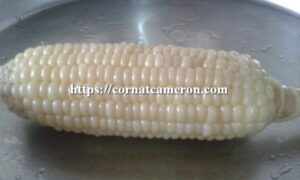White Sweet Corn History
History of White Corn
Description/Taste
White corn is a sweet corn variety. Its ears are wrapped in tightly layered pale lime green to white husks. One ear of corn can contain up to 400 kernels growing in rows lengthwise. Both the kernels and milk of white corn are creamy white in color. The kernels have a very high percentage of sugar and water in their composition. When at their prime ripeness (the milking stage) the kernels will be tender, sweet, and succulent. As the ear matures the water content decreases, the sugar turns to starch and the kernels become tough with a doughy consistency.

Pure white sweet corn
Types of Corn
Different types of corn are grown throughout the world, with one important difference being color. Corn kernels can be different colors ranging from white to yellow to red to black. Most of the corn grown in the United States is yellow, whereas people in Africa, Central America, and the southern United States prefer white corn. Yellow corn is not popular in Africa for reasons associated with the perception of social status: apparently, it is associated with food-aid programs and is perceived as being consumed only by poor people. Also, the feed industry consumes mostly yellow corn in the manufacture of animal feed. But the main reason for the preference for white corn is simply one of tradition: people are used to eating a white product in these countries, usually the whiter the better. This preference means lower consumption of β-carotene and β-cryptoxanthin, vitamin A precursors, present in higher concentrations in yellow and orange corn. This also shows up in the preference for meal and flour made with higher extraction rates, which are whiter than the whole-grain products, but also with lower contents of fiber, vitamins, and minerals. The quality of white maize is important since it affects the milling performance, grading, and yield of high-quality products.
Seasons/Availability
White corn is available year-round.
Current Facts
White corn is a member of the grass family Gramineae. Corn, known historically as maize outside of the English language, is technically classified as a grain crop, though when harvested young, it is utilized as a vegetable. Its stalks produce a cob of seeds, which are better known as the kernels, though by botanical definition they are the individual fruits of the plant. Corn varieties are classified essentially by their purpose. The amount of starch in any given corn variety will determine if it is used for sweet corn, feedstock corn, popping corn, flour corn, or biofuel corn, among other designations.
Applications
The less white corn is cooked, the better the flavor and texture. White corn can be roasted, grilled, blanched, steamed, or pureed. White corn’s bright and sweet flavors lend well to pasta and salads. It pairs well with tomatoes, basil cilantro, lobster, pork, chanterelles, truffles, shelling beans, cream, nutty cheeses, peas, summer squashes, fennel, citrus, and scallops. Corn is dried and ground into flour for baked goods, tortillas, and cereals and used as a crust/crisping agent for dishes both savory and sweet. Corn is also used for oil, as a sweetener in foods and beverages, and as a base for beverage alcohol.
Ethnic/Cultural Info
White corn was the single most important crop of pre-Columbian North America. It formed the identities of the Mesoamericans & North Americans as a staple food source. Corn is part of the Native American “Three Sisters” planting method where corn, squash, and beans are planted simultaneously. The ancestral source of sweet corn is Andean corn, named Chullpi. This corn contains the quintessential sugary gene that identifies sweet corn as the best fresh eating corn. Its high sugar content contributes to a fermented alcohol drink called Chicha, popular in Bolivia and drunk with dried Chullpi snacks.
Geography/History
Corn is native to the Americas, specifically Mexico. Wild corn was domesticated by indigenous Mesoamericans in prehistoric times. A wild grass, Teosinte (Zea Mexicana) is considered the ancestor of all known species of corn. Teosinte grows wild in remote areas of Mexico and Guatemala. The oldest known remains of corn were discovered in Mexico’s Valley of Tehuacan and dated 2750 BC, approximately 7,000 years old. Corn is still the number one grain crop grown in the Americas. It continues to be a significant source of food and now fuel security, providing at least 12 billion bushels annually for agricultural and industrial use.
According to a genetic study by Embrapa, corn cultivation was introduced in South America from Mexico, in two great waves: the first, more than 6000 years ago, spread through the Andes. Evidence of cultivation in Peru has been found dating to about 6700 years ago. The second wave, about 2000 years ago, through the lowlands of South America.
An influential 2002 study by Matsuoka et al. has demonstrated that, rather than the multiple independent domestications model, all maize arose from a single domestication in southern Mexico about 9,000 years ago. The study also demonstrated that the oldest surviving maize types are those of the Mexican highlands. Later, maize spread from this region over the Americas along two major paths. This is consistent with a model based on the archaeological record suggesting that maize diversified in the highlands of Mexico before spreading to the lowlands.
After the arrival of Europeans in 1492, Spanish settlers consumed maize, and explorers and traders carried it back to Europe and introduced it to other countries. Spanish settlers far preferred wheat bread to maize, cassava, or potatoes. Maize flour could not be substituted for wheat for communion bread since in Christian belief only wheat could undergo transubstantiation and be transformed into the body of Christ. At another level, Spaniards worried that by eating indigenous foods, which they did not consider nutritious, not only would they weaken, but they risked turning into Indians. “In the view of Europeans, it was the food they ate, even more than the environment in which they lived, that gave Amerindians and Spaniards both their distinctive physical characteristics and their characteristic personalities.” Despite these worries, Spaniards did consume maize and archeological evidence from Florida sites indicates they cultivated it as well.
Corn spread to the rest of the world because of its ability to grow in diverse climates. It was cultivated in Spain just a few decades after Columbus’s voyages and then spread to Italy, West Africa, and elsewhere. Sugar-rich varieties called sweet corn are usually grown for human consumption as kernels, while field corn varieties are used for animal feed, and various corn-based human food uses (including grinding into cornmeal or masa, pressing into corn oil, and fermentation and distillation into alcoholic beverages like bourbon whiskey), and as chemical feedstocks.
By 1575 corn had been introduced into the Philippines, Indonesia, and western China. It was also taken to Africa where it has become a staple food. It was useful in that continent during the years of the slave trade, as although people were transported to the colonies in the New World, corn helped the population to grow rather than to diminish from illnesses such as malnutrition and because of the fact that so many people were transported.
Corn contains some the B-complex vitamins including B1 (thiamin), B2 (niacin), B3 (riboflavin) B5 (pantothenic acid), and B6, making corn good for hair, skin, the digestion, heart, and brain. It also contains vitamins C, A, and K along with amino acids, flavonoids, large amounts of beta-carotene, and a fair amount of selenium which improves the functions of the thyroid gland and plays a role in the proper functioning of the immune system. Beta-carotene is also found in tomatoes, papaya, pumpkin, and red peppers. Corn, therefore, possesses potent antioxidant properties that help to protect the body from the ravages of free radicals which can damage the cells and cause cancer. Corn also contains fiber which is essential to our diet. It also helps with the production of sex and stress-related hormones and is good for our sexual health especially that of men as niacin can help with erectile dysfunctions.
It is believed that it can help with the symptoms of arthritis and rheumatism as the B-complex vitamins can improve joint mobility.



Normally I do not learn article on blogs, but I wish to say that this write-up
very pressured me to check out and do so! Your writing style has been amazed me.
Thank you, very nice article.
Wow! This blog looks exactly like my old one! It’s on a totally different subject but it has pretty much the same page layout and design.
Wonderful choice of colors!